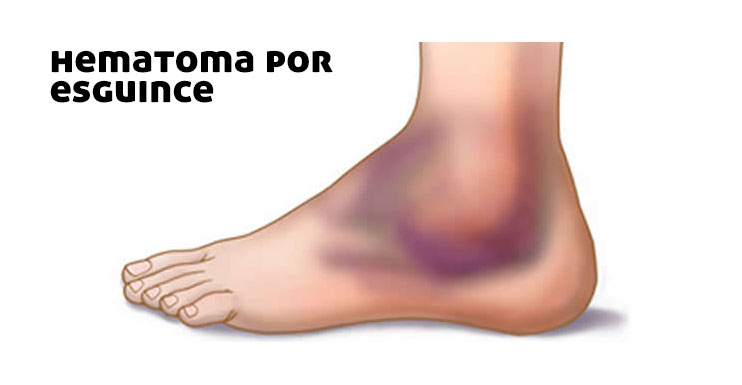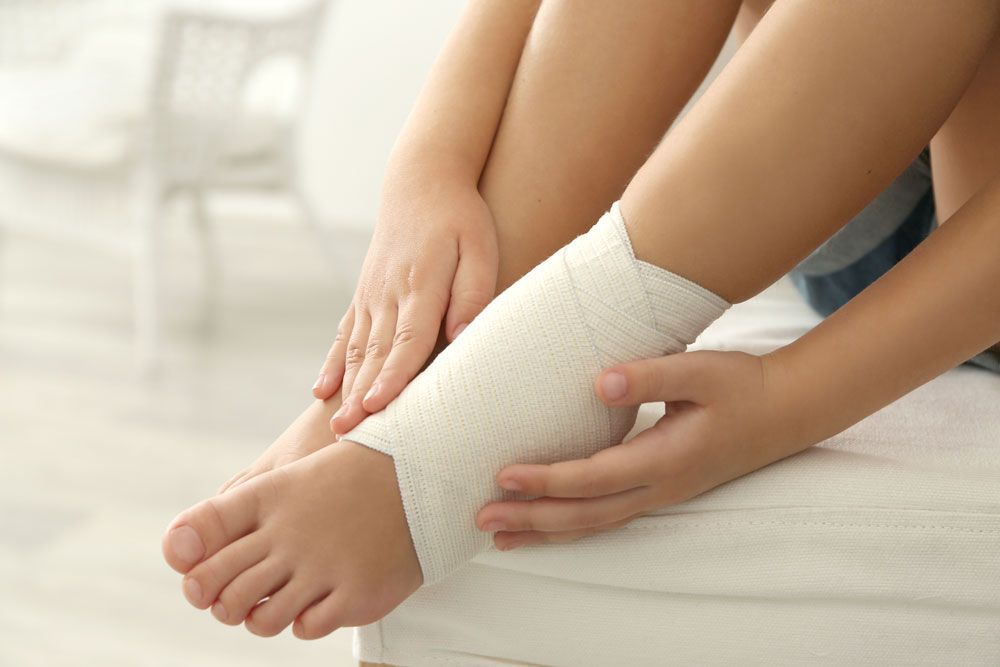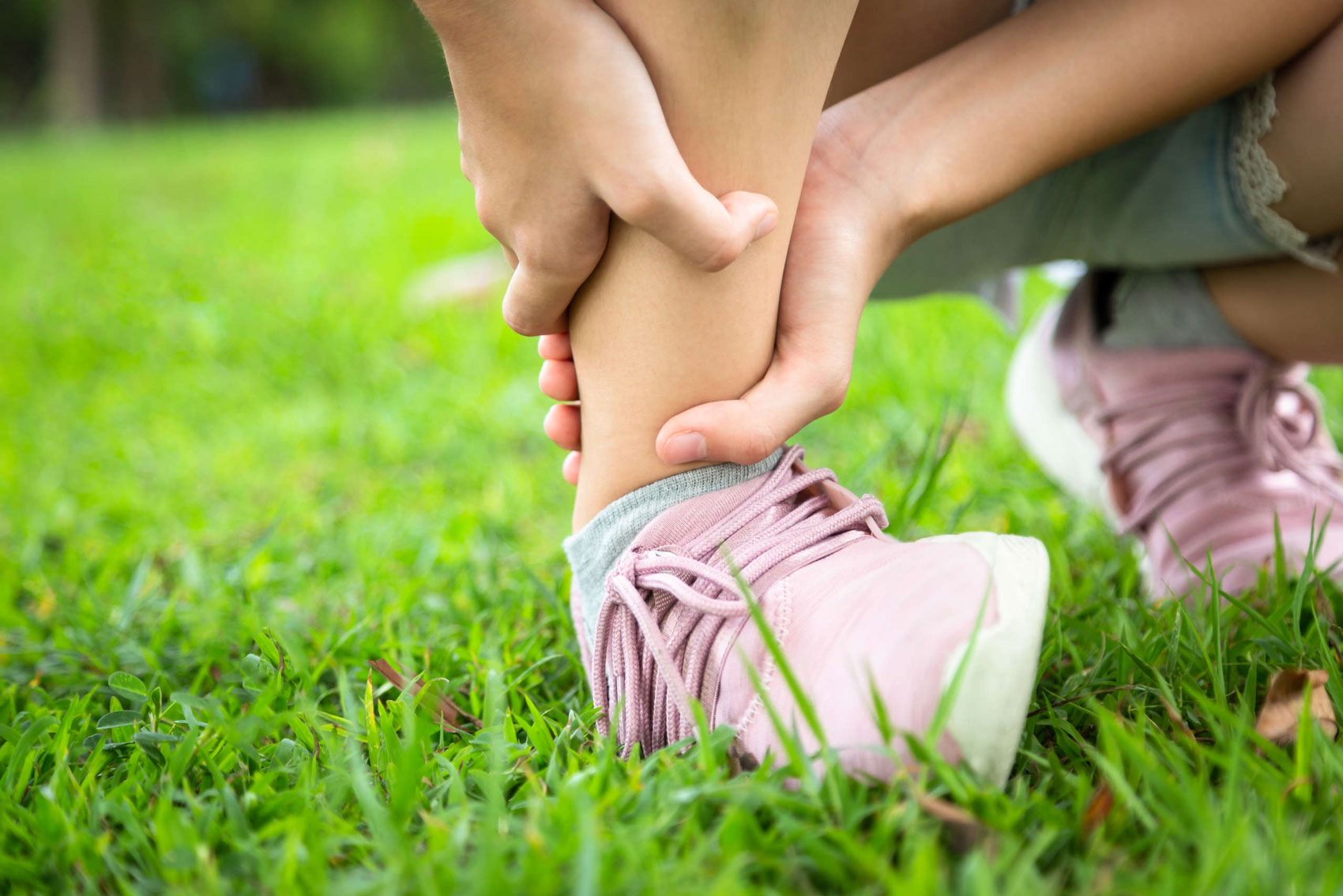My child has hurt his/her ankle, can it be serious?
– ”Sprained ankles”.
What is a sprain?
Today, there is an increasing functional demand in children, their growth is accelerating and the intensity of sporting activities is increasing. A recent US study determined the incidence of ankle injuries between 2002 and 2006: the peak incidence was between 15 and 19 years of age (7.2 per 1,000 persons per year) with a large majority of males. Trauma occurred in almost 50% of cases during sporting activities. (1) (1)
Ankle sprains are a frequent reason for consultation among children and adolescents, and the increase in their incidence may be related to early pubertal development as well as to an increase in childhood obesity. (2) The incidence increases especially from the age of 10 years onwards, since in younger children there is usually a high degree of ligamentous laxity, with epiphysiolysis (growth plate fractures) being more frequent in them. (1,3) (1,3)

It is one of the most prevalent traumatic musculoskeletal injuries. Its aetiology is closely related to an inversion injury mechanism in 95% of cases (4). Its occurrence is frequent in sports such as athletics, football, basketball or dance. It accounts for 40% of sports injuries. (5-8) (5-8) Training sessions of up to 20 hours per week are frequent in school sports centres. (9-10) (9-10) The starting age for intensive training is decreasing and programmes that expose children to excessive amounts of exercise are increasing, which increases the risk of injury. (11-12) (11-12)
Hoy are they classified?
Depending on the instability that causes the injury, sprains can be classically classified into three grades: (3)
- – Grade I: characterised by distension of ligament fibres without rupture or instability with minimal functional impotence.
- – Grade II: there is partial ligament tear with slight instability.
- – Grade III: there is complete ligament tear with joint instability.
However, from a practical point of view it is still interesting to classify them clinically, according to the degree of inflammation: (13)
- – Mild: The child can stand and even walk with tolerable pain without swelling.
- – Moderate: The child can support and stand but walking is limited as there is swelling, oedema and mild ecchymosis
- – Severe: The child is unable to stand due to pain. Completely swollen ankle with significant ecchymosis.

How are they treated?
The treatment of this type of pathology is conservative. It will depend on the degree of inflammation and functional impotence. Before starting any treatment, it is important to carry out a correct anamnesis and physical examination. It is important to know data such as the date of the traumatism, the circumstances of its appearance, the type of pain, etc. This is important in order to be able to better orientate the treatment. The child’s traumatic history should always be taken into account.
If a fracture is suspected, a radiological study of the foot and ankle is requested, antero-posterior and lateral projections of the same, taking into account the patient’s age and the Ottawa rules for radiological studies. CT (computed tomography) is a complement to visualise the bone plane and helps in the diagnosis when a bone or cartilage fragment is detached. MRI (magnetic resonance imaging) allows the study of capsulo-ligamentous structures to detect any continuity solutions present (14).
Ankle sprains are commonly treated following the PRICE (Protection, Rest, Ice, Compression, Elevation) method (15). In addition, exercises are used to improve range of motion, strength and proprioception.(16) These four preventive rules and the prescription of NSAIDs (non-steroidal anti-inflammatory drugs) are intended to minimise pain, oedema and erythema in order to promote mobilisation as early as possible(17) in both acute and overuse pathologies. (16, 18-19)
Aspects to be taken into account in the treatment of this pathology according to its stage:
- – Grade I or slight sprain: Apply local cold (e.g. ice for about 20 minutes, every 2 hours) and apply compressive bandaging, together with elevation and unloading or partial loading for 2-3 days. Subsequently, perform proprioceptive physiotherapy to prevent the occurrence of new sprains in the future. (3) (3)
- – Grade II or moderate sprains: Apply local cold (e.g. ice for about 20 minutes, every 2 hours), and apply compressive bandaging, together with elevation of the foot and NSAIDs. Avoid resting the foot for approximately one week. Subsequently, when the inflammation has subsided, functional bandages can be applied to gradually start walking and support, or orthoses can be fitted. It is also helpful to use proprioceptive physiotherapy to prevent further sprains in the future. (3) (3)
- – Grade III or severe sprain: The treatment of grade III injuries is more controversial because this type of injury usually does not have a good prognosis regardless of the treatment method chosen. Some authors recommend primary surgical repair as the method of choice, others recommend functional treatment with different phases of controlled rapid mobilisation and, finally, others advise immobilisation with plaster or rigid orthoses. (20) (20) Immobilisation time varies from 3 to 6 weeks depending on the case (13).
How can they be prevented in the future?
If the sprain is not treated or is poorly treated, it can generate a real sporting handicap due to the feeling of instability and functional insecurity it causes during running and walking, for example (21). Con el crecimiento y aumento de la edad, disminuye la laxitud ligamentosa y, con ello, la tendencia a los esguinces de repetición (3)
Si el esguince no se trata o se trata mal, puede generar un verdadero hándicap deportivo por la sensación de inestabilidad y de inseguridad funcional a la que da lugar durante la carrera y la marcha por ejemplo (21). Only if no positive results are obtained after conservative treatment, and after at least 6 months of evolution of recurrent or chronic sprains, following a complete study including an arthro-CT scan, can surgical treatment be proposed, which has been well described by authors such as Langlais et al. (22) Y siempre debe ser la excepción. (22)
Bibliography
-
Waterman BR, Owens BD, Davey S, Zacchilli MA, Belmont Jr PJ. The epidemiology of ankle sprainsin the United States. J Bone Joint Surg Am 2010;92:2279–84
-
Vacquerie, V. Esguinces de tobillo en niños y adolescentes. EMC – Podologi¬a. 2015;17(1):1–8.
-
López J. Fracturas infantiles más frecuentes. Esguinces y epifisiolisis.Pediatr Integral.2019; 23(4): 221.e1–221.e14
-
Launay F. Sports-related overuse injuries in children. Orthop Traumatol Surg Res [Internet]. 2015;101(1):S139–47
-
Browne GJ, Barnett PL. Common sports-related musculoskeletal injuries presenting to the emergency department. J Paediatr Child Health [Internet]. 2016;52(2):231– 6
-
Frisch A, Croisier J-L, Urhausen A, Seil R, Theisen D. Injuries, risk factors and prevention initiatives in youth sport. Br Med Bull [Internet]. 2009;92(1):95– 121.
-
Faude O, Röbler R, Junge A. Football Injuries in Children and Adolescent Players: Are There Clues for Prevention? Sport Med [Internet]. 2013;43(9):819–37
-
Doherty, C., Delahunt, E., Caulfield, B. y col. Incidencia y prevalencia de la lesión por esguince de tobillo: revisión sistemática y metaanálisis de estudios epidemiológicos prospectivos. Sports Med.2014;44:123-140
-
Fridman L, Fraser-Thomas JL, McFaull SR, Macpherson AK. Epidemiology of sports-related injuries in children and youth presenting to Canadian Emergency departments from 2007–2010. BMC Sports Sci Med Rehabil. 2013;5(1):30
-
Doral MN, Tandogan RN, Mann G, Verdonk R, editores. Sports Injuries: Prevention, Diagnosis, Treatment and Rehabilitation. Heidelberg: Springer-Verlag; 2012. p. 989-94
-
Paterno MV, Taylor-Haas JA, Myer GD, Hewett TE. Prevention of Overuse Sports Injuries in the Young Athlete. Orthop Clin North Am. 2013;44(4):553-64
-
Maffulli N, Longob UG, Spiezia F, Denaro V. Aetiology and prevention of injuries in elite young athletes. En: Armstrong N, McManus AM. The Elite Young Athlete. London: Basel- Karger; 2011. p. 187-200
-
Del Castillo Codes M, Martínez A. D. Síndromes dolorosos del pie en el niño. Rev Pediatr Aten Primaria.2001;3:67-84
-
Toscano Pardo JM, Alonso Pérez Y, Melián Díaz J. Utilidad de las reglas de Ottawa para tobillo y medio pie en Atención Primaria. Validez (I). Medicina General y de Familia. 2016
-
Arnold A, Thigpen CA, Beattie PF, Kissenberth MJ, Shanley E. Overuse Physeal Injuries in Youth Athletes. Sport Heal A Multidiscip Approach [Internet]. 2017;9(2):139– 47
-
Soprano J V. Musculoskeletal injuries in the pediatric and adolescent athlete. Curr Sports Med Rep [Internet]. 2005;4(6):329–34
-
Guillodo Y. El tobillo del deportista. EMC – Tratado Med. 2012; 16(4):1-5
-
Cassas KJ, Cassettari-Wayhs A. Childhood and Adolescent Sports-Related Overuse Injuries [Internet]. 2006.
-
Gerbino PG. Elbow disorders in throwing athletes. Orthop Clin North Am [Internet]. 2003;34(3):417–26.
-
Ardevol J, Bolíbar I, Belda V, Argilaga S.Treatment of complete rupture of the lateral ligaments of the ankle. Knee Surg Sports Traumatol Arthrosc 2002;10(6):371-7
-
Chrestian P, Sarrat P, Cohen M. Entorses de la cheville de l’enfant et de l’adolescent. EMC-Elsevier Masson SAS, Podologie. 2003;27-050-A-80: 7p
-
Langlais J, Chrestian P, Ceuca D, L’Kaissi M, de Billy B. Les instabilités chroniques de la cheville de l’enfant et de l’adolescent. En: de Billy B, Langlais J, Dutoit M, Zambelli PY, editores. Reprises et séquelles en traumatologie de l’enfant. Montpellier: Sauramps Medical; 2010. p. 241–52.




